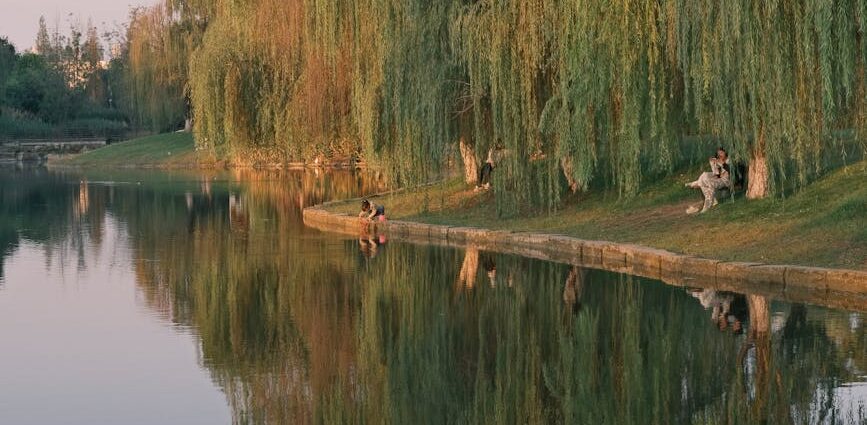I’ve always felt a strange kind of intimacy with nature, a pull that seems both personal and ancient. Willow trees especially, they’ve always felt like kin to me, the way their branches bend, soft and forgiving, yet strong enough to endure storms. When my nan passed away, that connection deepened. Her garden was filled with trees, planted by my aunt, grown into silent witnesses of decades of family life. I don’t yet know the names of all those trees, but I want to. Learning their names feels like learning the family history we never wrote down.
We tried, for a moment, to dig them up, to take them with us. But the soil reminded us quickly, these were not possessions to carry away, they were rooted lives of their own. We left them behind, but I carried away a sharper awareness: what if the trees are relatives too, just as central to memory, to lineage, to survival, as the people we mourn?
The Earth as Alive


This is not a new thought. In Braiding Sweetgrass, Robin Wall Kimmerer writes about learning the worldview embedded in her Native Potawatomi language: one where the Earth is not “it” but a living being with whom we’re in relationship. In her words, “In the Western tradition there is a recognised hierarchy of beings, with, of course, the human being on top… But in native ways of knowing, humans have the least experience with how to live, and thus the most to learn.” (Kimmerer, 2013, p. 9). It flips the script many of us were raised with.
This shift is echoed across the globe:
- Māori worldview (Aotearoa New Zealand): The Whanganui River is legally recognized as a living ancestor, with the same rights as a person (BBC, 2017).
- Andean cosmology (Quechua, Aymara peoples): Pachamama (Mother Earth) is honored as a being who sustains life, with rituals of reciprocity central to daily practice (Gudynas, 2011).
- Brazilian Indigenous voices: Ailton Krenak emphasizes that dreaming, singing, and storytelling are ways of sustaining the cosmic life we belong to (Krenak, 2023).
- Hindu traditions: Trees such as the peepal are considered sacred, often understood as embodiments of divinity and protectors of life (Haberman, 2013).
- African cosmologies: Among the Shona people of Zimbabwe, trees are seen as living spirits, guardians that connect the community with ancestral presence (Chirimuuta, 2006).
These perspectives challenge the Western framework where nature is objectified, separated from us, stripped of subjectivity. They ask us to reimagine Earth as alive, relational, and inseparable from culture.
Trees as Kin
Jessica Hernandez’s Fresh Banana Leaves (2022) expands this conversation. She recounts how her father survived a bombing only because a banana tree shielded him, a reminder that “tree as relative” is not metaphor but lived truth. Hernandez critiques how practices like permaculture are often celebrated without acknowledgment of Indigenous roots, calling it a subtle continuation of colonization (Hernandez, 2022). Her insistence is clear: Indigenous knowledge is foundation.
This recognition resonates with my own feelings. When I breathe, I think of trees, their oxygen sustaining me, the same way mythologies once imagined gods gifting breath to humans. In Genesis, life begins when God breathes into Adam’s nostrils. In Greek myth, Prometheus shapes humanity from clay and breathes life in. What if, instead of distant deities, it was always the trees, standing right beside us, gifting us every inhale?
A New Way of Seeing
The Western story often casts us as rulers of nature. But what if we were siblings instead, or even the youngest children, learning slowly from the older, wiser beings around us? What if saying hello to a tree wasn’t sentimentality but etiquette?
As I think about my nan’s trees, about my own willows, about the names of plants I still need to learn, I feel the urgency of this shift. If we continue to see trees as background scenery, we risk forgetting they are our breath, our memory, our continuity.
“Like creation stories everywhere, cosmologies are a source of identity and orientation to the world.” — Robin Wall Kimmerer (2013, p.7)
Maybe the real task is to remember that we are not separate. We are, and have always been, family.


References
- Kimmerer, R.W. (2013). Braiding Sweetgrass. Milkweed Editions.
- Hernandez, J. (2022). Fresh Banana Leaves. North Atlantic Books.
- BBC (2017). “New Zealand river granted same legal rights as human being.” https://www.bbc.com/news/world-asia-39282918
- Gudynas, E. (2011). “Buen Vivir: Today’s tomorrow.” Development, 54(4). https://www.sciencedirect.com/science/article/pii/S1877343511000285
- Krenak, A. (2023). Ancestral Future. Polity.
- Haberman, D. (2013). People Trees: Worship of Trees in Northern India. Oxford University Press.
- Chirimuuta, C. (2006). Shona Religion and Beliefs. Mambo Press.

